Introduction
Business technology projects have steadily evolved from a tactical to a strategic focus and competence over the years. Nowadays, organizations that equally value technology and business strategies sustain a more substantial Strategic Alignment with IT and software projects achieving higher funding priority and improved board room commitment. Projects are core to the business model and strategy realization and produce the desired outcomes when the corporate strategy is explicitly defined, communicated, and aligned with the project portfolio. IT project outcomes directly support dynamic and quality-based product development and delivery, customer value generation, and highly-productive business processing, representing definite competitive advantages.
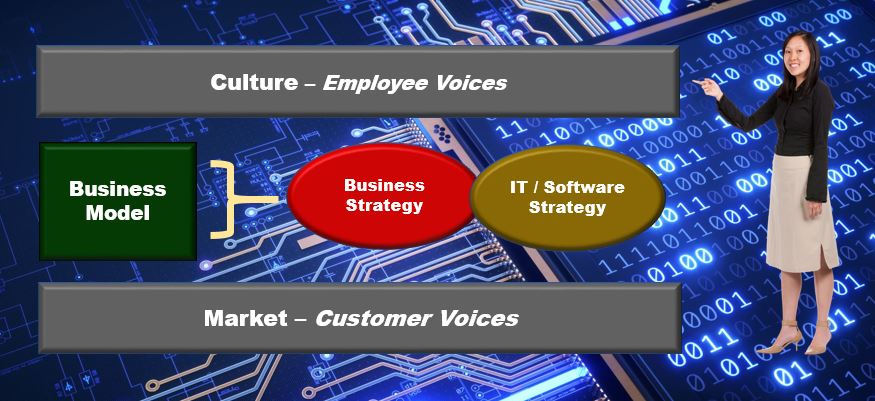
“A fully aligned project, program and portfolio management strategy encompasses the entire organization, dictating project execution at every level and aiming to deliver value at each step along the way.”
Project Management Institute (PMI)
The majority of smart business leaders may openly appreciate and support IT / software solutions’ value to business success. Many may have difficulty obtaining colleagues’ concurrence on the necessary culture and policy changes and allocating financial and human resources. Without board room acceptance, strategic projects will lack executive commitment and linkage with the organization’s business strategies and validation with critical Leading and Lagging Indicators and KPI (Key Performance Indicators – KPIs).
The PMI 2020 Pulse of Profession Report highlights that 70% of management-level participants favor creating a culture centered on customer value delivery enabled by visible and robust project management. However, about 50% were powerless to drive the necessary cultural and resource commitments.
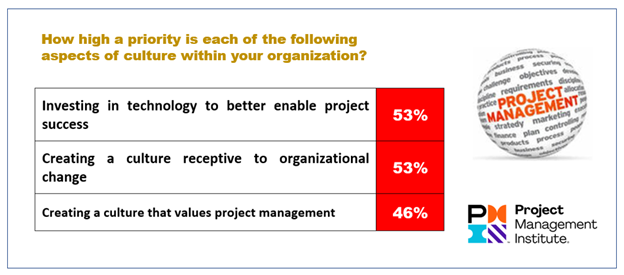
Anecdotal evidence suggests that the failure to influence critical corporate changes results from a mix of generational attitudes and preferences, well-entrenched ‘sacred cows,’ and lack of strategic thinking skills and focus among the management team. A solid starting point to changing these situations centers on acknowledging the business leaders’ inclination to successfully promote and actively implant IT / software development and project management value in their cultural characteristics and strategic decision-making.
Organizations need to reimagine technology requirements through the current and future business model and strategies and customer-prioritized requirements voices to ensure strategic relevance, funding appropriateness, and executive team consensus. This approach will empower executives at all corporate levels to act without hesitation, willingly accept direct project ownership, and passionately ‘walk the talk’ for priority customer-facing and business processing strategic software initiatives.
“Large IT efforts often cost much more than planned; some can put the whole organization in jeopardy. The companies that defy these odds are the ones that master key dimensions that align IT and business value.”
McKinsey
Software Development Project Influencers
Software development projects have traditionally presented a challenge to deliver to scope, time, and budget. PMI 2020 research identifies that 13% of projects fail, and project failure accounts for 37% of the budget loss. These statistics are alarming for any sized organization and may have a significant impact on overall financial health. In past years project failure with project management breakdown was the principal dilemma to address concerning the corporate project portfolio.
As we embark on 2021, COVID-19 presents new and complex challenges for developing system and process improvements to streamline internal and customer-facing interactions, employee personal wellbeing and security, and reduce unnecessary cyber exposure and risks. The introduction of pandemic-focused responses with new software will necessitate evaluating the current software projects and setting priority based on financial and other considerations. A discussion follows on the challenges facing many organizations in successfully addressing the problems facing software project management.
“The greatest danger in times of turbulence is not the turbulence—it is to act with yesterday’s logic.”
Peter Drucker
Software Project Outcomes
In the best of times, software development is a challenge and fraught with missed deadlines, failure to deliver, underestimated budgets, and unusable products. Collective research supports that a significant universe of organizations in all major industries continually encounters difficulties in delivering projects to scope within requirements, on time, and within budget, while meeting stakeholder objectives and expectations. After much investment and employee effort, software projects frequently fail to deliver planned outcomes and benefits and introduces unwanted risk to the business!
Project outcomes generally are identified within the three categories described below.
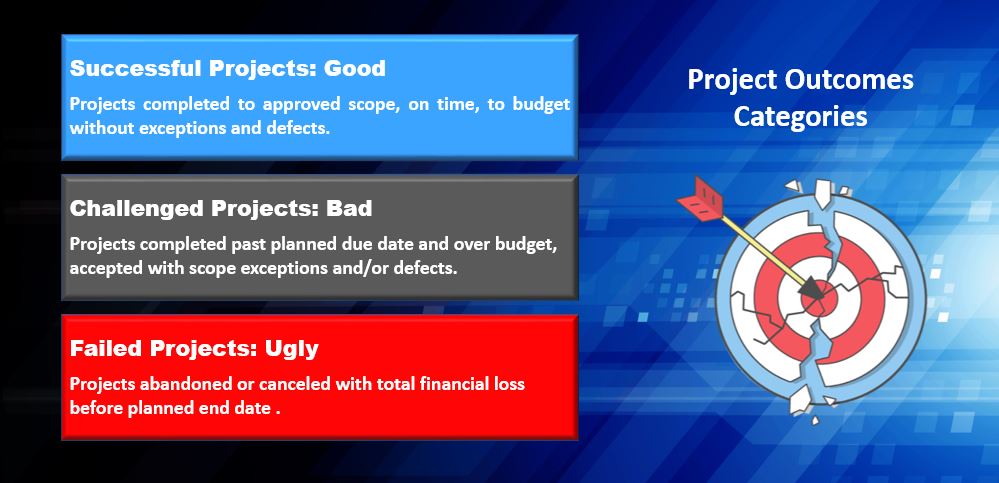
In recent years, a compilation of industry research reports and articles reveals that project outcomes regularly identify at 20% for successful, 60% for challenged, and 20% for failed projects.
Projects that fail or only somewhat deliver on their financial and commercial objectives can adversely affect corporate productivity and profitability. There are many causes for the continual problematic projects that range from low to severe quantifiable and qualitative impacts.
Experience supports that failed IT/software projects typically reveal meaningful symptoms or “early warning signs” of problems long before the breakdown. The lack of an enterprise-wide project management culture with analogous artifacts represents a pivotal failure contributor for many organizations.
As all businesses are culturally and strategically unique, it is essential to recognize the particular ‘failure points’ of harmful project outcomes. A large selection of books and articles exist that address project management. Most of these excellent publications present content on project practices and tactics to avoid project failure. Still, it may not be easy to collect and summarize all of this valuable knowledge. The below table is a useful reference for identifying the critical project failure points found in most projects.



“If you can’t describe what you are doing as a process, you don’t know what you are doing.”
W, Edwards Deming
A failed project typically exhibit one or more’ failure points’ as symptoms during the project’s lifecycle. Failure points generally reflect a lack of a reinforcing culture that values project management, the absence of strongly-committed executive owners, and inadequate project management and governance. The graphic below presents a selection of the primary high-level ‘best practices’ to ensure successful project deliverables.
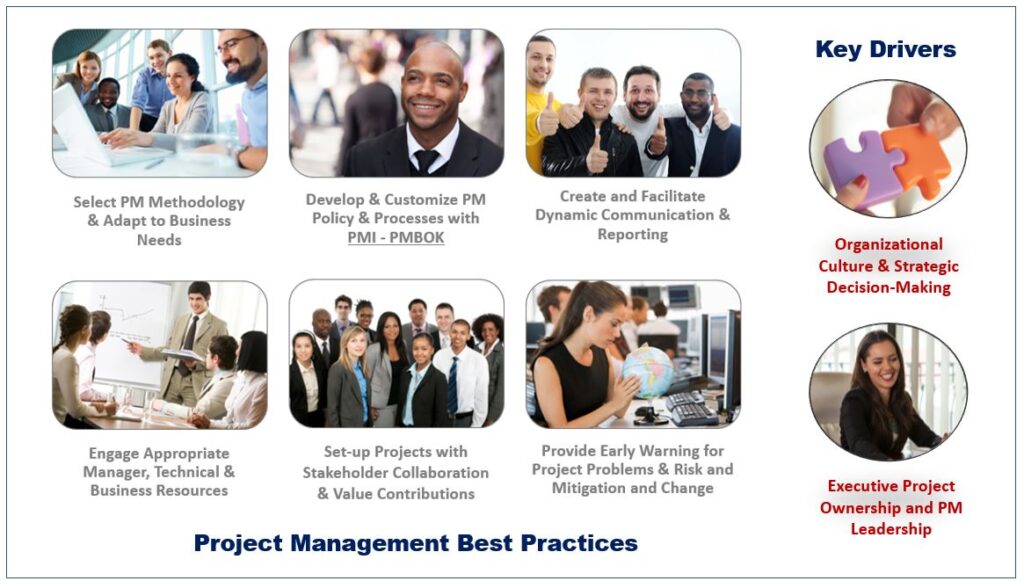
Project Management ‘best practices’ are the functional usage of the well-recognized concepts, processes, and tools specified in the PMI PMBOK and other similar knowledge sources developed over the years by academia and industry professionals. No ‘best practice’ is suitable for every organization and typically are adjusted to meet specific corporate conditions and needs. Also, business circumstances may change in the future and necessitate replacing or modifying the application of particular ‘best practices.’
“Ultimately, project delivery is essential for the modern organization as a tool for delivering strategic change and driving bottom-line performance improvement.”
KPMG, International Project Management Association (IPMA) & Australian Institute of Project Management (AIPM)
COVID-19 New Software Initiatives Needs
As the business community responds to the aftermath of the COVID-19 and plans for the post-crisis ‘next normal‘ corporate realities and priorities are necessitating a rethink of the traditional workplace setting and IT / software project management. An ambitious focus should identify the need for new or enhanced existing software and systems to meet modern workplace requirements. The new requirements need analysis and judgment with the organization’s current software projects for priority-setting and go forward decisions, including temporary hold, cancellation, and repurposing.
The pandemic has also compounded the resource management dilemma when the crisis response drives new functionality and dedicated solutions, and likely capital redeployment. In this unsettled environment, projects will be larger, more complex, and increasingly challenging to control and successfully deliver.
The increased project demands present a critical decision-point for business leaders, given the scarcity and potential unavailability of budget and required skilled resources. In many companies, current internal and offshore projects may need to be canceled or placed on hold, repurposed with resources diverted to crisis-related priorities.
A practical course of action prescribes conducting Project Health Assessments of the existing and planned projects, programs, and portfolios o identity priorities, validating values and funding, providing executive ownership, setting up a PM environment, and assigning resources and governance responsibilities.
“69% of boards report accelerating digital business initiatives in response to COVID-19.”
Gartner
Software Project Health Assessments
Objectively assessing a project’s health becomes even more problematic as projects increase in scope, scale, and technical intricacy. There is no single ‘silver bullet’ policy, process, technique, or team resource composition known to deliver a highly-successful software project. Often, project managers and their team struggle to see the ‘forest-for-the-trees’ focusing on the mountains of project minutiae. Commonly project employees lose perspective with an unbalanced investment of time and effort with tactical details versus a constant strategic focus on meeting customer-focused scope requirements and quickly identifying and resolving project cost and time problems and risks.
It is a well-accepted business truism that the cost of fixing or repairing a technical obstacle or blockage is much higher than the price of preventing or avoiding the incidence beforehand. Impending business and technical problems can also go unnoticed because project managers historically operate with a ‘slow and steady wins the race’ mentality. The confidence that everything within the project will be copasetic by adhering to the plan without change is not a guarantee of positive outcomes. Effective project plans are organic that change as required to support risk mitigation and successful project delivery.
A Project Health Assessment (PHA) is an unbiased, methodical assessment of an individual project, program, or portfolio’s status. The technique substantiates conformity to organizational PM policies and standards; identifies the ‘gaps’ with PM best practices, and identifies and assesses the existence of harmful project problems and risks and associated impacts. The deliverable is an objective appraisal of a project’s current status and value and its likelihood of successfully producing the planned business and technology deliverables. Conducting a project health assessment is a valuable exercise that enables organizations to:
- Recognize if a project is over/under budget and ahead/behind schedule, and exceeding or missing client or sponsor scope requirements;
- Detect subtle and tacit early warning risk and problem symptoms that could evolve into downstream project breakdown if missed;
- Discover high-impact PM best practices’ gaps’ in the current PM environment;
- Generate remedial’ lesson learned’ responses to close the PM practices ‘gaps’ and align with PMI PMBOK.
- Incorporate ‘lessons learned’ within the corporate project management office (PMO) policies and processes to support standardized and repeatable projects.
- Improve decision-making for overseeing noxious projects: turn-around go and/no-go judgments, resource restructuring, and funding adjustments.
- Confirm that the project’s rationale is still relevant and clearly understood by the project team owner or sponsor, project manager, and stakeholders;
- Support prioritization and decisions for individual projects, programs, portfolio reauthorization, combination, cancellation, or delay.
“If a window of opportunity appears, don’t pull down the shade.”
Tom Peters
Project Health Assessment: Analysis Elements
The ‘best practice’ for a project health assessment scope focuses on using the PMI PMBOK (7th edition) Project Performance Domains as critical analysis elements. Each of the eight domains shown below consists of an array of valuable reference points customizable to a particular organization’s business needs and preferences.
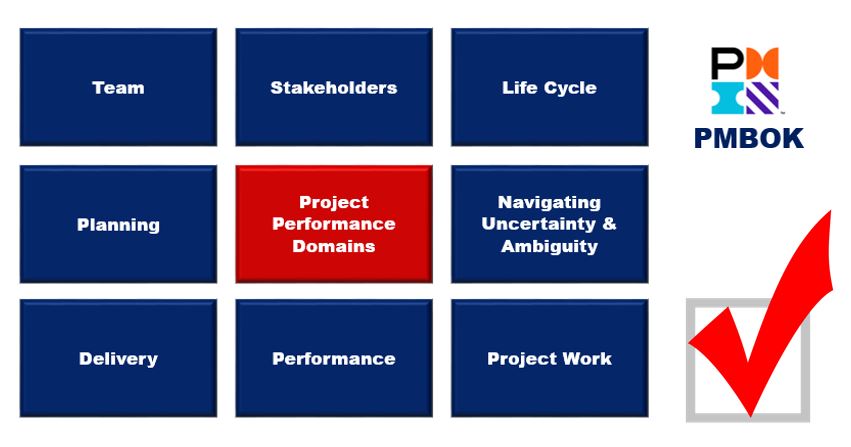
PMI defines Project Performance Domains’ as a group of related activities critical for delivering successful project outcomes. The below table provides a brief description of each domain.
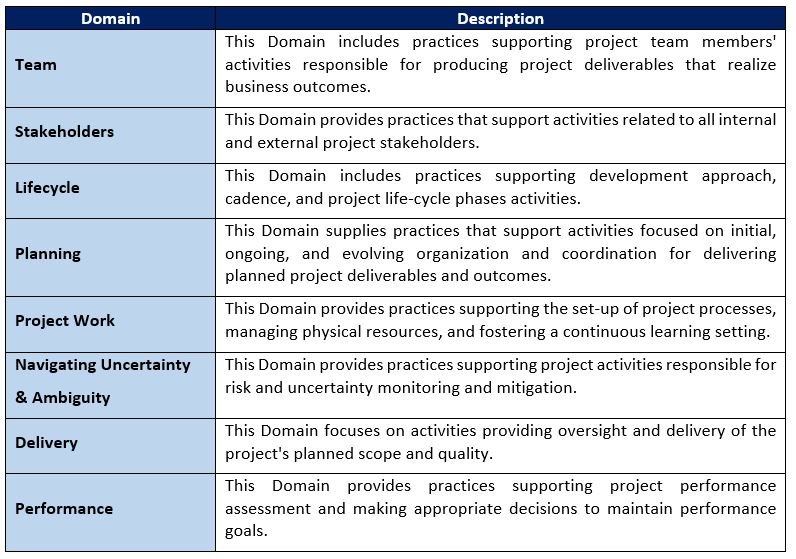
Project Health Assessments: The Process & Techniques
The essential decision points for a project health assessment set-up consists of identifying and agreeing on goals, scope, approach, outcomes and deliverables, roles, and responsibilities. The assessment approach is all about the process and support activities and techniques to be used. Outlined below is a practical list of assessment activities used by organizations with highly-effective PM environments.
- Collecting all supporting pertinent project documents from the business case to current project status reports;
- Conducting one and one and group interviews with project owners, the project manager and team members, and other relevant stakeholders;
- Performing a ‘gap’ analysis with the existing organizational PM policies and practice and targeted project, programs, or portfolio;
- Performing a ‘gap’ analysis of existing organizational PM policies and practices with PMI PMBOK practices;
- Filtering and analyzing data and information gathered in all tacit and explicit assessment interactions and exercises using surveys and analysis tools and techniques;
- Generating an executive-level report documenting the critical findings, conclusions, benefits, risks, and recommendations, along with all documents, information, and statistics used as report sources.
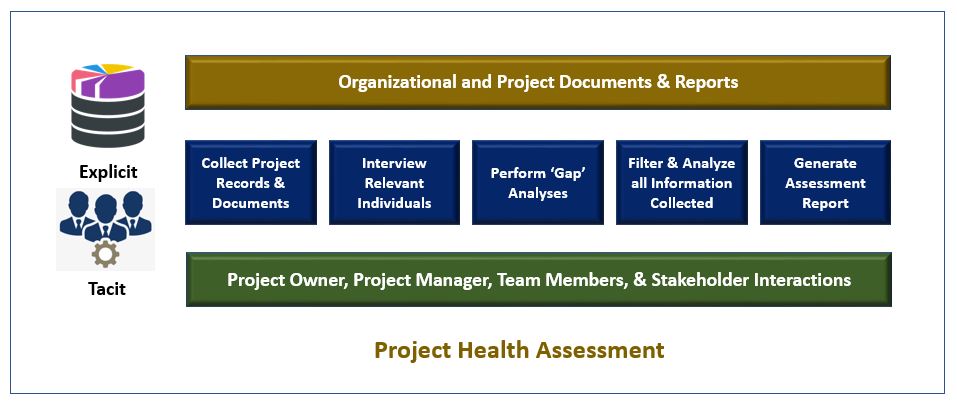
The project health assessment process includes using various analysis tools and techniques to manage documents and information from databases and stakeholder interactions. They include surveys, brainstorming, interviewing, root cause analysis, causal data analysis, decision trees, and predictive data analysis available in many software solutions.
Project Health Assessments: Metrics & KPIs
Project management metrics / KPIs provide insightful data to help identify a project’s value, status, foresee problems and risks during its life cycle, redirect or reorganize the project, and determine a project’s success or failure. Robust metrics and KPIs are visible, measurable, recognized, and accepted by management and stakeholders, and validate the project’s business value to the organizational business strategy.
Project metrics include both quantifiable and qualitative measures to gauge performance, conduct, and progress. Metrics are created by collecting data from digital and human sources to track the business project’s goals. Not every metric can be a Key Performance Indicator (KPI) and thus require selection and prioritization. The decision on metric inclusion and KPI focus tagging is usually vested with the manager or management team responsible for the particular strategic initiatives and project ownership.
The framework and practices used to perform a project health assessment are contingent on the project’s goals, scope, business strategy impacts, and existing project management policies and processes. The metrics selected as KPIs require alignment with the assessment’s goals and the quantifiable and qualifiable information and data needed to verify project status and value and enable quick and sound project-specific go/no-go and funding decisions.
As all project health assessments are business-specific, it is necessary to create a personalized metrics list for an organizational entity. A sampling of standard project metrics used to manage project life cycles and support project health assessments follow for consideration.
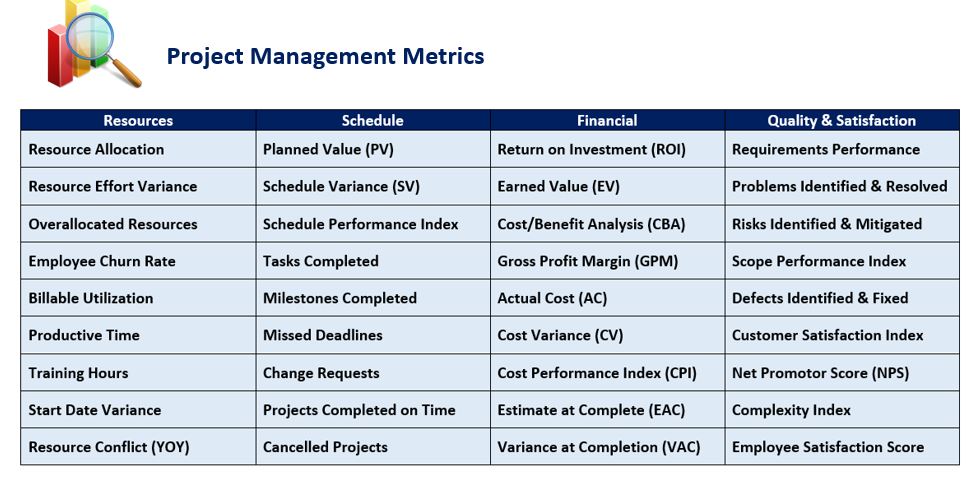
“Be a yardstick of quality. Some people aren’t used to an environment where excellence is expected.”
Steve Jobs
The Way Forward
At Knowledge Compass, we bring together nearly four decades of thought leadership in business and technology strategy, the latest tools and best practices, and a seasoned consultant team with the competencies and talent to help our clients improve productivity and profitability.
Knowledge Compass explores and develops valuable new insights from business, technology, and science by embracing the powerful technology of ideas and brainstorming. Our consultants engage customers in challenging discussion and experimentation to expand business science boundaries and practice and translate creative ideas into practical solutions from within and beyond business.
Working with Knowledge Compass means a collaborative approach to understanding your current business model, strategies, and critical business requirements and goals.
We enable organizations to transform and deliver improved value by ensuring employees adapt and make the most effective use of crisis management and change practices in culture, strategy, infrastructure, processing, and digital transformation. Our consultants have a deep understanding of the social and business factors that support a people-based culture aligned with the appropriate corporate strategy and goals.
Knowledge Compass provides consulting services using time-tested best practice frameworks, analysis tools, and interactions from their professional Consultant Toolbox.


